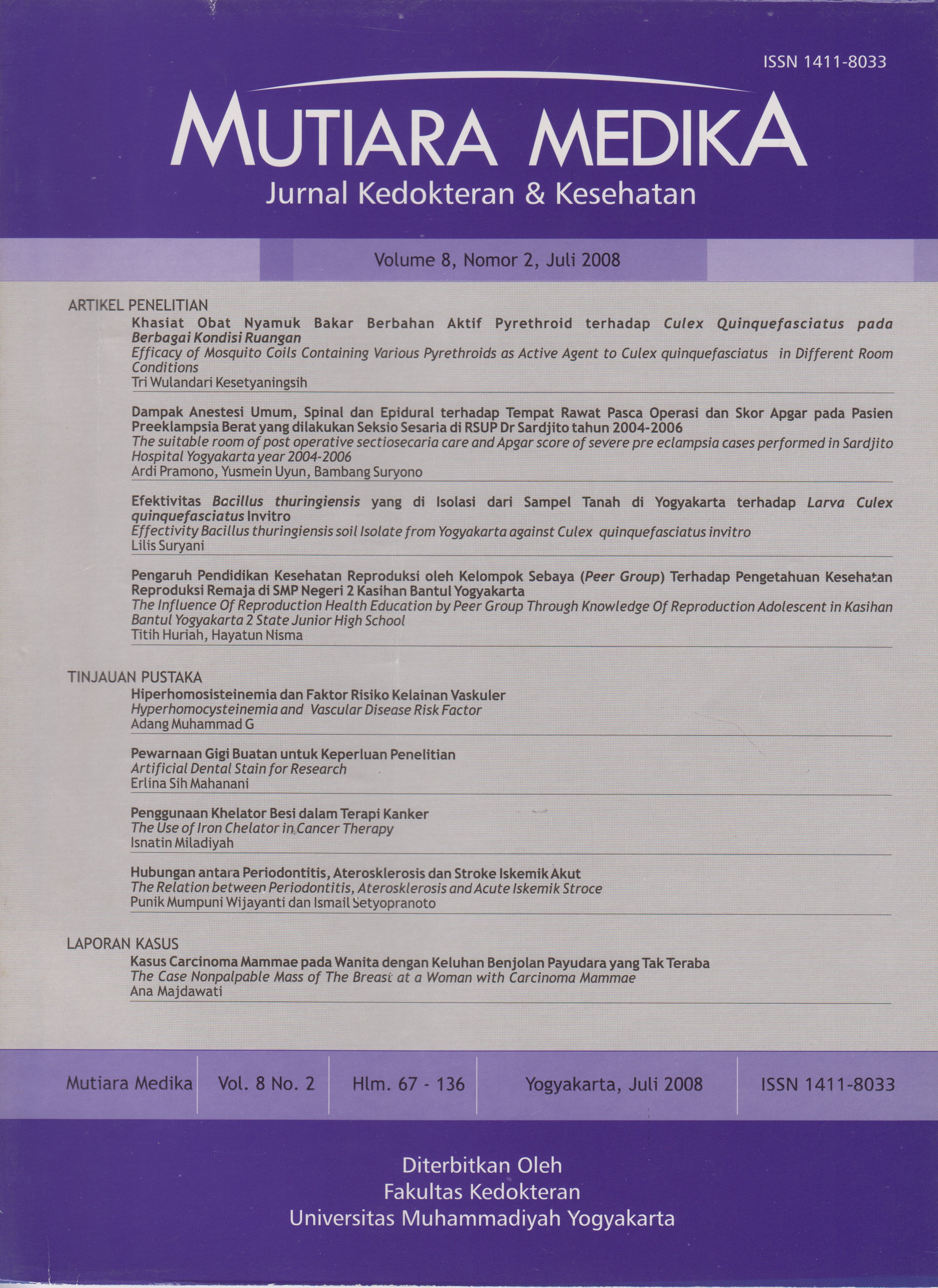Pewarnaan Gigi Buatan untuk Keperluan Penelitian
DOI:
https://doi.org/10.18196/mmjkk.v8i2.1480Keywords:
chlorhexidine, dental stain, method, tea, metoda, pewarnaan gigi, tehAbstract
Nowadays, regarding the increased of aesthetic demands, the dental staining is a common problem. It can be caused by exogenous or endogenous source. It may adhere directly to the surface, contain within calculus and soft deposit, or incorporate within the tooth structure. Many studies are conducted to evaluate the ability of material or herbal to remove or inhibit dental staining. Therefore it is needed a method to produce the artificial stain for specimen.
This article has an objective to give information about the artificial dental stain for research. Combination between chlorhexidine and tea has been reported that it can produce fast and optimum artificial stain. Meanwhile it is needed artificial saliva to stimulate pellicle in the specimen surface so the stain source can attach. The clear acrylic block is used as a specimen and spectrophotometer for measuring the optical density of staining and Lobene score index for visual assessment.
Pewarnaan gigi adalah masalah yang seringteijadi, bisa disebabkan faktor dari dalam maupun dari luar, dan dapat bersifat sementara di permukaan, bersatu dengan karang gigi ataupun telah masuk dalam struktur gigi. Banyak penelitian dilakukan untuk mengetahui kemampuan suatu bahan untuk mengurangi atau mencegah terjadinya pewarnaan gigi. Oleh sebab itu diperlukan suatu metoda penelitian untuk menghasilkan pewarnaan buatan pada spesimen.
Tujuan penulisan artikel ini adalah untuk memberikan suatu gambaran metoda pewarnaan gigi buatan untuk keperluan penelitian. Kombinasi antara teh dan obat kumur chlorhexidine telah banyak diteliti dapat menghasilkan pewarnaan yang cepat dan optimal. Selain itu diperlukan saliva buatan untuk menghasilkanpellicle di permukaan spesimen sehingga sumber pewarna bisa menempel. Digunakan akrilik jernih sebagai spesimen dan spektrofotometer untuk mengukur optical density pewarnaan gigi dan Lobene skor indek untuk penilaian visual.
References
Wilkin E.M, (1999) Dental stain and discoloration. Clinical Practice of the Dental Hygienist8th Edition. Lippincott Williams & Wilkins, 285-286
Addy,M.& Moran, J.(1995) Mechanism of stain formation on teeth, in particular associated with metal ions and antiseptics. Advances in Dental Research 9, 450-456
Watts, A.& Addy, M, (2001). Tooth discoloration and staining: a review of the literature. British Dental Journal 190,309-316
Greenwall L (editor), Freedman GA, Gordan W, Haywood VB, Kelleher, M, Mclaughin G, and Rotstein I (2001) Whitening Toothpaste: Bleaching Techniques In restorative Dentistry .1st Edition. Martin Dunitz Ltd, 42-44
Eriksen HM, Nordbo H (1978) Extrinsic discoloration of teeth. J Clin Periodontol 5: 229-36.
Murray JJ, Nunn J.H.and Steele J.G, (2003). Chemical that can help to reduce plaque formation. The Prevention of Oral Disease.4th Edition. Oxford University Press,136-138
Addy M, and Moran J (1984) The formation of stain on acrylic surfaces by the interaction of cationic antiseptic mouthwashes and tea. J Bioned Mater Res 18(6):631-41.
Addy M, Moran J, Griffiths A, and Wills- Wood N J (1985). Extrinsic tooth discolouration by metals and chlorhexidine. I: Surface protein denturation or diet precipitation? Br Dent J, 159:331-334.
Leard A and Addy M (1997). The propensity of different brands of tea and coffee to cause staining asscociated with chlorhexidine. J Clin Periodontol, 24(2): 115-8.
Eley BM (1999). Antibacterial agents in the control of supragingival plaque- a review. BrDentJ, 186: 286-96
Pontefract H, Courthey M, Smith S, Newcombe RG and Addy M (2004). Development of methods to enhance extrinsic tooth discoloration for comparison of toothpastes. 1. Studies in vitro. J Clin Periodontol, 31 (1): 1 -6.
Joiner A (2006). Review of the extrinsic stain removal and enamel/dentine abrasion by a calcium carbonate and perlite containing whitening toothpaste. Int DentJ, 56(4):175-80.
Sharif N, MacDonald E, Hughes J, Newcombe RG, and Addy M (2000). The chemical stain removal properties of ‘whitening’ toothpaste products: studies in vitro. British Dental Journal, 188(11):620-24.
Manab EEA, and Arief EM. (2006). The Effectivness of two whitening toothpastes at removing tea and cholhexidine stain: in vitro study. Elective Report Project of DDS, School of Dental Sciences, USM
Samuel SV, ES Mahanani, and EM Arief (2007) The Effectivness of Salvadora persica at removing tea and chlorhexidine stain. Elective Report Project of DDS, School of Dental Sciences, USM
Sheen S, Banfield N, and Addy, M. (2001). The propensity of individual saliva to cause extrinsic staining in vitro- a developmental method. Journal of Dentistry 29, 99-102
Lobene, R. A (1968). Effect of dentifrices on tooth stain with controlled brushing. Journal of the American Dental Association 77.849-855
Downloads
Published
Issue
Section
License
Copyright
Authors retain copyright and grant Mutiara Medika: Jurnal Kedokteran dan Kesehatan (MMJKK) the right of first publication with the work simultaneously licensed under an Attribution 4.0 International (CC BY 4.0) that allows others to remix, adapt and build upon the work with an acknowledgment of the work's authorship and of the initial publication in Mutiara Medika: Jurnal Kedokteran dan Kesehatan (MMJKK).
Authors are permitted to copy and redistribute the journal's published version of the work (e.g., post it to an institutional repository or publish it in a book), with an acknowledgment of its initial publication in Mutiara Medika: Jurnal Kedokteran dan Kesehatan (MMJKK).
License
Articles published in the Mutiara Medika: Jurnal Kedokteran dan Kesehatan (MMJKK) are licensed under an Attribution 4.0 International (CC BY 4.0) license. You are free to:
- Share — copy and redistribute the material in any medium or format.
- Adapt — remix, transform, and build upon the material for any purpose, even commercially.
This license is acceptable for Free Cultural Works. The licensor cannot revoke these freedoms as long as you follow the license terms. Under the following terms:
Attribution — You must give appropriate credit, provide a link to the license, and indicate if changes were made. You may do so in any reasonable manner, but not in any way that suggests the licensor endorses you or your use.
- No additional restrictions — You may not apply legal terms or technological measures that legally restrict others from doing anything the license permits.






